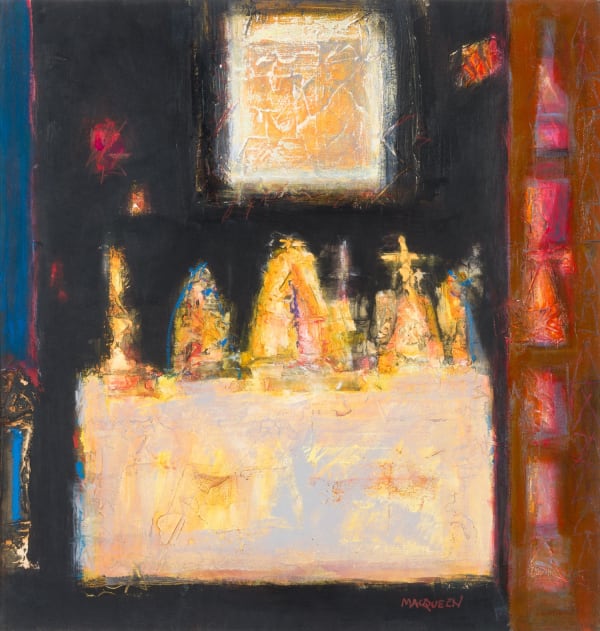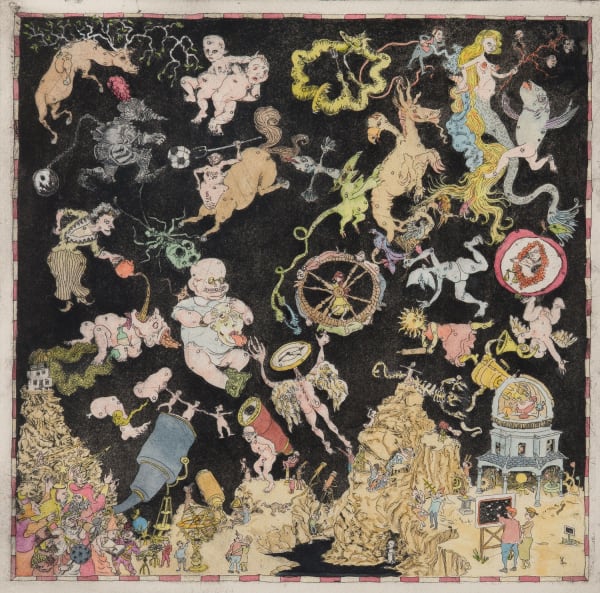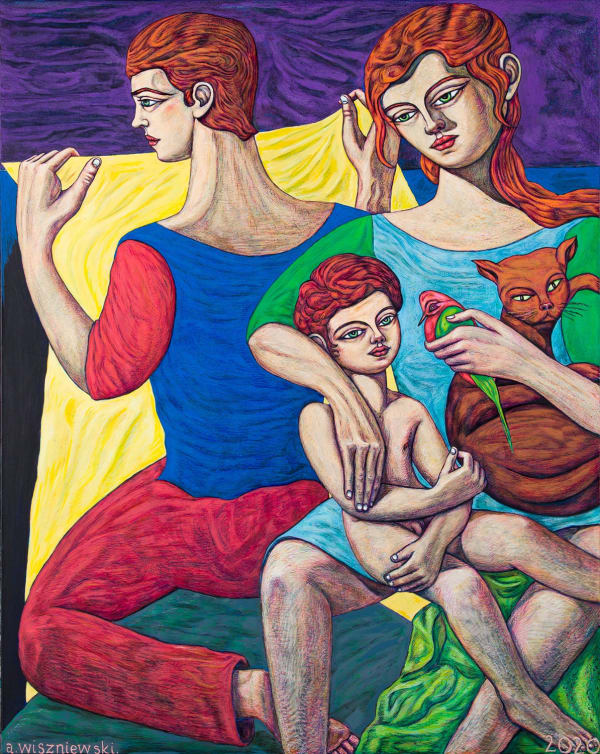-
Vibrations, as the Beachboys sang, lead to excitations.
Paintings are arranged outside on the gravel in front of me. They are placed in the sun with a backdrop of flowers. I notice a tiny blob of pink floating among the blues and greys of a seascape. Sometimes an exhibition greets with a wall of painted energy… or it lacks this, and we walk past. It is about vibrations – good, good, good vibrations - when colour, composition and narrative grip. Outside as I look at the paintings, bees buzz around the sweet blue catmint. We are not so different from the bumbles. Vibrations, as the Beachboys sang, lead to excitations.
Colour literally excites the retina, tingling the cones of photoreceptors: longer red waves sparking some cones and shorter violet waves of light other ones. This creates a small charge of electricity and activates chemical changes within our bodies. It is a physical thing, a nourishment and a need.
Composition lets an artist create mini-stories: worlds of balance that with a single well-placed mark can be given movement and catalysed into life. Moments of creation don’t always need God’s painted hand. Sometimes a little pink blob is enough. If done well, a painting can be like a cathedral or a primal humanless world. It can offer sanctuary.
There is a difference between one tree, three trees and four trees and 3.14 trees. Good composition delves consciously or subconsciously into an underlying foundation of numbers. Some of these numbers are stable (four or eight,) some energise (three or seven) and some are magical – 3.14 (pi) or 1.61 (the golden ratio.) There is also negative space, and soon, under it all, we enter a landscape of geometry and repeating dimensions. Art takes us to the beautiful analogue and the infinite and it offers an alternative to digitation of cyberspace: one, zero, zero, one, zero, one. Here are a few of the vibrations in Kilmorack Gallery. There are too many to list, so these are just a few examples.
Charles MacQueen is a master of colour and composition. In ‘Night, Jodpur,’ composition draws our eye through an arch and towards a suggested opening. This is echoed in MacQueen’s colours. We fall into a pulsating blue. It is hard to know when a painting is completed, but it is when ‘it feels right’ MacQueen told me. This is when the vibrations are good.
Liz Knox balances colour, like stacking stones on a beach. Each hue is carefully placed, so another one can be placed on top of it, folding complexity into balance. After leaving School, the young Liz Knox worked at Coats Paton in Paisley, arranging the cotton thread manufacturer’s famous colours. Her success is in knowing exactly what each colour does.
Adrian Wiszkniewski’s sophisticated paintings take his often powerful, bright pallet and harmonise it. Not only is there a playful story-narrative (the human condition) in Wiszniewski’s paintings, but there is also a colour-narrative and a line-narrative. This draws us to his paintings three times.
Landscape painter Allan MacDonald uses the texture of light and dark to create his subject. In MacDonald’s work, there is no Damascene light without darkness and the waves he paints must come against unyielding rock. It is the interplay of these opposing forces that create life. This dance suggests greater forces at work.
Kirstie Cohen with her deep, rich oil paintings is most often thought of as a landscape artist, but they are also psychological works. Moods of colour, deep heavy-hanging darks and incoming moments of light are an inner world she balances on canvas. It is this active-balance that Cohen strives towards, and she would happily let the landscape vanish to make it work.
The inconceivably detailed and often satirical work of Robert Powell uses his microscopically detailed marks to suggest both the mass of humanity and the smallness of it. It is his aim, he told me, to paint everybody in the world – past, present and future - into a single (small) painting.
There are few things in life that are infinite, but good, good, good vibrations are. They will always lead to excitations.
-
-

Allan MacDonald
Allan MacDonald is one of Scotland's most important landscape artists. MacDonald's work is in the Northern Romantic trandition, looking for the energies behind the landscape and for poetry in paint. -

Alan Macdonald
Scottish Alan Macdonald was born in Malawi and graduated from Duncan of Jordanstone College of Art, Dundee. He spent his early career in London before relocating to Scotland. His work... -

Charles MacQueen RSW RGI
Charles MacQueen (b 1940) is a Scottish artist, born in Glasgow. He now lives in Fife with his partner Christine Woodside. Charles MacQueen's work evokes the colour, texture and light... -

Paul Bloomer
Paul Bloomer’s work explores the tensions and connections between opposing forces, using birds as metaphors to explore war and peace, dark and light, present and eternity, physical and spiritual, life... -

Kirstie Cohen
Kirstie Cohen's work stands out in Scottish landscape painting. Technically it is different from others as it is created by the laborious process of layering and manipulating thin glazes of... -

Liz Knox
1945 - 2024LIZ KNOX is one of those rare artists who has immaculate technique. Colour, composition, texture and light are all used with a deftness that brings power to all the subjects... -

Robert Powell
ROBERT POWELL's work is in a European tradition of dark humour all carried out with incredible flair and expression. His work includes a series of sixteen etchings exploring 'a universal... -

Adrian Wiszniewski
-
Good, good, good, good vibrations: colour, composition and excitations
Past viewing_room











